Australia’s late Kenneth Cook is one of the world’s great neglected writers. His 21 novels are little known outside Australia, and pretty scarce even in their native land. It seems that if Cook is remembered at all these days it’s for his 1961 debut novel WAKE IN FRIGHT (which was made into a well known 1971 film).
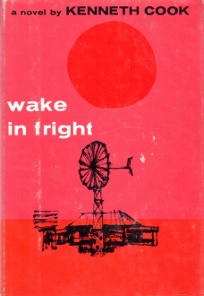 That situation is not entirely inappropriate, as WAKE IN FRIGHT remains Cook’s masterpiece. It’s a blistering depiction of grit and desperation that announced Kenneth Cook as Australia’s answer to American scribes like Hubert Selby Jr. and Charles Bukowski. It also set the tone for most of Cook’s succeeding novels, in which (to quote a back cover blurb from one of them) “human beings are forced to confront the truth about the wild side of Australia—and the reality of their own natures.”
That situation is not entirely inappropriate, as WAKE IN FRIGHT remains Cook’s masterpiece. It’s a blistering depiction of grit and desperation that announced Kenneth Cook as Australia’s answer to American scribes like Hubert Selby Jr. and Charles Bukowski. It also set the tone for most of Cook’s succeeding novels, in which (to quote a back cover blurb from one of them) “human beings are forced to confront the truth about the wild side of Australia—and the reality of their own natures.”
The central character is a refined schoolteacher who in order to obtain his credential finds himself teaching in a desolate town in the Australian outback. Kenneth Cook’s depiction of the outback is far from the opulent wonderland depicted in movies like WALKABOUT and CROCODILE DUNDEE, being a desolate wasteland packed with Cro-Magnon toughs who shoot kangaroos for fun, and who the protagonist falls in with while on his Christmas vacation. In this company our “hero” finds his own darker instincts bubbling to the fore, and his life spiraling out of control.
WAKE IN FRIGHT remains one of the absolute best descent-into-savagery stories I’ve ever encountered, presenting a fully rounded character caught up in a horrifically convincing spiral that challenges all our notions of “civilized” behavior. Add to that some truly gut-wrenching brutality (the kangaroo killings are described in extremely intimate detail) and you’ve got a novel that’s over 50 years old yet reads like it was written yesterday.
Kenneth Cook followed this triumph with 1962’s CHAIN OF DARKNESS, another superbly grungy look at the Australian outback distinguished by 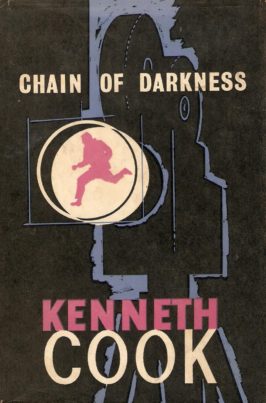 economic prose and three dimensional characters. In contrast to the naturalistic drama of the former novel, this one is a taught chase thriller that transposes the exploits of Johnson, a petty criminal who becomes the subject of a manhunt after accidentally killing a cop, with those of Davidson, an overzealous TV reporter covering the story.
economic prose and three dimensional characters. In contrast to the naturalistic drama of the former novel, this one is a taught chase thriller that transposes the exploits of Johnson, a petty criminal who becomes the subject of a manhunt after accidentally killing a cop, with those of Davidson, an overzealous TV reporter covering the story.
The point, of course, is to show that these two men are both equally corrupt and dishonest in their respective practices. I’m sure this was a novel premise back in 1962, but these days it’s a bit old-hat. The novel, however, is still a powerfully brutal and tension-filled read, with Johnson committing another murder and Davidson finding himself with an unexpected interview opportunity when his subject confronts him and his crew at gunpoint. There’s also some vivid nastiness (as when Johnson, pursued through farmland and growing increasingly ravenous, kills a possum and eats its innards raw) and a disturbingly convincing sense of near-documentary realism.
1963’s STORMALONG was Cook’s third novel, and a letdown. It is once again a quintessentially Australian portrayal of violence and desperation, headlined by Paul, a devoutly Catholic boatshed owner. Cook himself operated a boatshed in his early years, and the experience is evident in this account, which is nothing if not convincingly detailed.
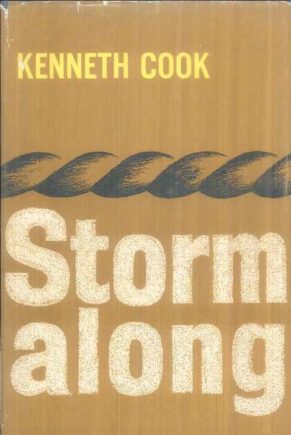 Unfortunately it’s also drawn-out and meandering, with a lot of excess wordage devoted to Paul’s attempts at wooing a married woman named Rebecca. Being Catholic, Paul has to get Rebecca’s marriage annulled in order to properly wed her, which turns out to be an extremely dull process (for him and the reader). Another impediment to Paul’s happiness is the intervention of a slimy opium smuggler named Harry Maine. Paul and his business partner Alan have an unpleasant confrontation with Maine, who retaliates by cutting all the boatshed’s boats loose from their moorings and eventually killing Alan.
Unfortunately it’s also drawn-out and meandering, with a lot of excess wordage devoted to Paul’s attempts at wooing a married woman named Rebecca. Being Catholic, Paul has to get Rebecca’s marriage annulled in order to properly wed her, which turns out to be an extremely dull process (for him and the reader). Another impediment to Paul’s happiness is the intervention of a slimy opium smuggler named Harry Maine. Paul and his business partner Alan have an unpleasant confrontation with Maine, who retaliates by cutting all the boatshed’s boats loose from their moorings and eventually killing Alan.
The murder doesn’t take place until STORMALONG’S final third, but I’m not spoiling anything by revealing it. Alan’s death, after all, is referenced numerous times before it actually occurs; it’s almost as if Cook realized his narrative was plodding and so inserted the presentiments of Alan’s demise to liven it up.
The novel concludes with a supremely guilty Paul, who can’t help but blame himself for Alan’s death, hitting the revenge trail in a too little-too late denouement.
WANTED DEAD, from 1963, was for some reason published under the pseudonym “Alan Hale.” Set during the late 1900s, it can be viewed as an Australian western, albeit a western of the revisionist sort that shuns conventional heroism and emphasizes gritty realism.
The “hero” is Riley, a wiry Irishman residing in the land down under who joins the police force, and is charged with hunting down violent outlaws who reside in the outback. Riley comes to regret his assignment after running into James Hatton, an imposing figure known as The Hangman—due to his habit of hanging anyone who annoys him—who Riley takes on, and bests, in a drag-out fight. This of course only leads to more trouble, and an apocalyptic shoot-out that raises the stakes considerably for everyone concerned.
Yes, there’s a great deal of violence in this account, enhanced by Cook’s stunningly vivid portrayal of the unforgiving terrain of rural Australia. This is all very much in keeping with Cook’s sensibilities, as is the narrative’s bleak trajectory—Hatton, you see, isn’t the only bad guy here, nor the most dangerous. Riley’s corrupt superiors are the true antagonists, and their pettiness makes itself apparent throughout this resolutely harsh and unrelenting account.
VANTAGE TO THE GALE, also from 1963, likewise appeared under the Alan Hale moniker. It was apparently the first novel Cook wrote, yet its initial  publication was halted due to concerns about potential libel suits. The reason for that was its protagonist, who was based on Rex Pilbeam, the mayor of a Queensland town who in 1953 was shot by his mistress.
publication was halted due to concerns about potential libel suits. The reason for that was its protagonist, who was based on Rex Pilbeam, the mayor of a Queensland town who in 1953 was shot by his mistress.
The Rex Pilbeam stand-in is Royston Sildon, the mayor of the South Australian town of Pantonville, who like Pilbeam is shot by a disgruntled lover. Sildon survives the bullet but is pilloried by his constituents. He becomes determined to win back the public’s favor, and does so in a succession of intricately planned maneuvers designed to garner as much favorable publicity as possible. The culmination of his efforts occurs during a catastrophic flood that strikes the town, bringing a great deal of wonton devastation (such as a young boy getting sucked into quicksand in a flood-ravaged bog). Sildon uses the disaster to his advantage, staging photo ops of him commandeering a rescue boat and rescuing a young child, which results in him winning back the love and respect of Pantonville—but, as Sildon is set to discover, his past indiscretions have not entirely gone away.
Several high profile scandals both past (the Pilbeam and Profumo Affairs) and future (the Watergate scandal) are reflected in VANTAGE TO THE GALE, which also directly foreshadows quite a few corrosive political satires (such as THE CANDIDATE and WAG THE DOG). Of course, Cook’s intent was anything but satirical in this lively yet quite harsh account of pettiness and infallibility, bearing a trajectory that might cheritably be called relentless.
THE TAKE was yet another pseudonymous novel hailing from 1963, and a definite step down. Credited to “John Duffy,” it’s the rarest of Cook’s novels (I doubt there are more than five copies in existence). It tells the story of Michael Hepburn, a journalist/director/something in a bustling newsroom, where he’s forced to contend with corrupt superiors who insist on smearing him as a communist and a lady monarch who does a TV interview topless and makes inappropriate (albeit quite tame by modern standards) sexual comments. Michael renders the interview broadcast-worthy by clever editing, which doesn’t improve his tenuous employment status, and leads to a subversive act of corporate sabotage.
If it’s possible for a novel to be both overwrought and underbaked, THE TAKE qualifies. It’s overwrought because there’s a great deal of evident padding, with belabored plot points and protracted multi-page dialogue exchanges (the novel likely began as a screenplay, and doesn’t appear to have been developed much beyond that state). It’s underbaked because the 130 page length isn’t nearly enough to do Cook’s narrative and thematic concerns justice. The novel is at best a missed opportunity, complete with on target but ham-fisted sociopolitical screeds like “Journalism is simply the pursuit of the ephemeral by the effete.”
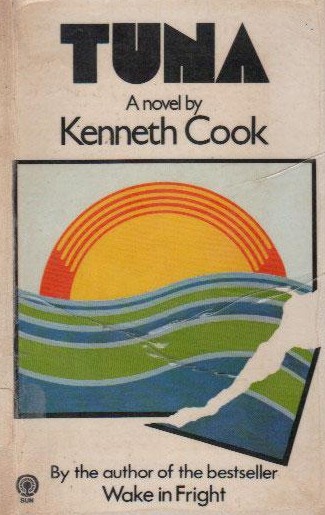 1967’s TUNA explores Australia’s fishing scene. It’s the relentless account of Jack Foster, a determined fisherman who purchases a fishing boat from some Italian tourists. Foster doesn’t have enough money to fully cover the price of the boat and so depletes his life savings in the hope that he’ll catch enough tuna to recoup his debts. As you might guess—this is, after all, a Kenneth Cook novel—catching Tuna is easier said than done. Eventually Foster manages to nab a boat-load of the stuff, but this entails a whole new set of problems, such as the fact that Foster’s boat isn’t equipped to carry such a high volume of fish.
1967’s TUNA explores Australia’s fishing scene. It’s the relentless account of Jack Foster, a determined fisherman who purchases a fishing boat from some Italian tourists. Foster doesn’t have enough money to fully cover the price of the boat and so depletes his life savings in the hope that he’ll catch enough tuna to recoup his debts. As you might guess—this is, after all, a Kenneth Cook novel—catching Tuna is easier said than done. Eventually Foster manages to nab a boat-load of the stuff, but this entails a whole new set of problems, such as the fact that Foster’s boat isn’t equipped to carry such a high volume of fish.
TUNA is prime Kenneth Cook, with vivid and colorful settings, an all-too-convincing depiction of the ugly side of the Australian fishing industry and a plethora of fully realized bottom-dwelling characters. It’s also an extremely suspenseful and absorbing account, even though it’s clear from the start that things are going to turn out badly for the beleaguered Jack Foster. Thus the narrative has the crude fascination of a foretold catastrophe: you read on, all the while dreading the inevitable tragic outcome—and, you can rest assured, it IS tragic!
Following stints as a politician (Cook was the co-founder of Australia’s Liberal Reform Group) and producer/screenwriter for film and television, Kenneth Cook turned out what I believe was his finest work since WAKE IN FRIGHT: 1974’s BLOODHOUSE. With this account of a wild night at a sleazy hotel located on the outskirts of Sydney, Cook tried something new, 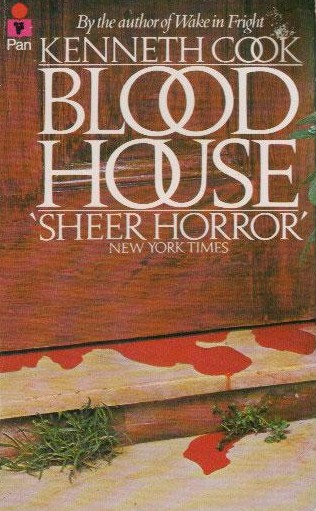 imbuing his usual brand of gritty drama with a strain of pitch-black comedy that was quite unprecedented back in 1974.
imbuing his usual brand of gritty drama with a strain of pitch-black comedy that was quite unprecedented back in 1974.
What occurs in the hotel over the course of the evening in question is interspaced with a succeeding court inquest, in which it’s established that amid “a scene of squalor, terror and confusion” someone was murdered. This knowledge hangs over the remainder of the book, which builds to a near-unbearable pitch of suspense as the hotel’s lowlife inhabitants grow increasingly rowdy, with brutality, prostitution, rape, underage drinking, a fatal car accident and a lost cat all contributing to the murder in question. The characters, all of whom end up thoroughly dehumanized, include two sleazy slaughterhouse workers, an effeminate young man looking to get laid, a naïve young woman who falls prey to all three, and the hotel’s piggish owner. Amidst all the madness Cook manages to insert his trademarked naturalistic observations with admirable unobtrusiveness, as well as a final twist you simply will not be able to predict, regardless of how hard you try.
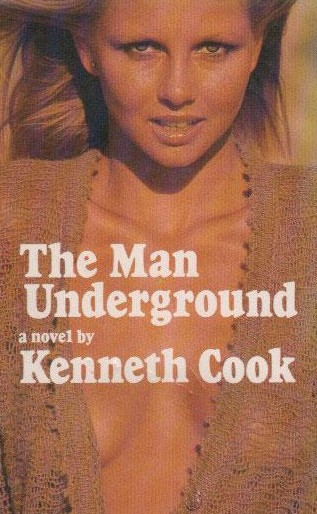 Onto 1977’s THE MAN UNDERGROUND. Once again we have a desperate man living in a sun-baked Australian Hellhole, in this case a godforsaken mining town called Ginger Whisker. The residents of Ginger Whisker reside in holes in the ground, spending their days mining for opal and their nights at the local bar. The protagonist Simon Crown, who relates the tale from a supremely jaded first person perspective, is a divorced sad sack who owns a mine and runs a radio station. Everything in Simon’s life is sordid and hopeless, at least until a comely woman moves into his hole and a rich businessman enters his life. Both would seem to offer a glimmer of hope, but Simon, being the cynical sort that he is, doesn’t think so—and indeed he’s right. The proceedings go from worse to worst when Simon’s mining partner discovers (or thinks he does) a super vein of opal in his mine, which of course only leads to more trouble.
Onto 1977’s THE MAN UNDERGROUND. Once again we have a desperate man living in a sun-baked Australian Hellhole, in this case a godforsaken mining town called Ginger Whisker. The residents of Ginger Whisker reside in holes in the ground, spending their days mining for opal and their nights at the local bar. The protagonist Simon Crown, who relates the tale from a supremely jaded first person perspective, is a divorced sad sack who owns a mine and runs a radio station. Everything in Simon’s life is sordid and hopeless, at least until a comely woman moves into his hole and a rich businessman enters his life. Both would seem to offer a glimmer of hope, but Simon, being the cynical sort that he is, doesn’t think so—and indeed he’s right. The proceedings go from worse to worst when Simon’s mining partner discovers (or thinks he does) a super vein of opal in his mine, which of course only leads to more trouble.
The narrative is a reasonably compelling one, even if Simon’s perpetually booze-addled perspective is a bit off-putting (it’s not unlike the ramblings of a barroom drunk spread out over an entire book). The setting is definitely a novel and intriguing one, enhanced by Cook’s unsurpassed descriptive skills. There are also some head-snapping twists, particularly toward the end, wherein we’re subjected to a genuinely shocking blast of outright depravity.
PLAY LITTLE VICTIMS (1978) is perhaps Cook’s most atypical novel, an ANIMAL FARM-like metaphoric fable with more than a hint of the satiric nastiness 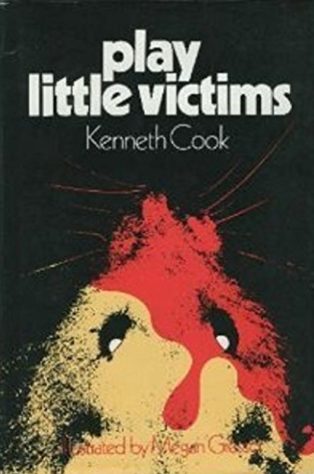 of Jonathan Swift’s “A Modest Proposal.” Missing is the documentary realism of Cook’s earlier novels, as well as the Australian settings, with the action situated in America.
of Jonathan Swift’s “A Modest Proposal.” Missing is the documentary realism of Cook’s earlier novels, as well as the Australian settings, with the action situated in America.
Profusely illustrated with Edward Gorey-esque drawings by the author’s daughter Megan Gressor, PLAY LITTLE VICTIMS is told in the all-knowing God’s-eye tone that tends to characterize fables, and indeed opens with God himself as the focus. It seems the big guy has grown tried of dealing with Earthly problems and so, in the year 2000(!), decides to put an end to all life on Earth. But He inadvertently leaves a couple of mice named Adamus and Evemus alive in the middle of the United States. Having been touched by the hand of God, Adamus and Evemus find themselves gifted (if that’s the word) with human levels of intelligence, and set about repopulating the deserted town where they find themselves situated.
At first everything runs smoothly, but Adamus and Evemus’ offspring reproduce at an alarming rate. Adamus and Evemus, together with an assistant named Logimus and a carefully selected governing board, attempt to control the population by consulting the literature left behind by mankind (specifically the Bible and the New York Times). They utilize war, automobiles, tobacco, alcohol and abortions, and even leak plutonium into the town’s water supply. Eventually, nearing the end of his life and facing the prospect of permanent overpopulation, Adamus hits upon a singularly macabre Final Solution that’s without precedent in the human kingdom. The tale ends, appropriately, with the following two sentences: “Logimus screamed. And screamed.”
The 1980s were difficult years for Kenneth Cook, with a costly divorce, bankruptcy and two highly ambitious but disappointing novels.
 1980’s PIG was the first of those novels. It’s essentially a more realistic variant on the Aussie horror flick RAZORBACK (1984), pivoting on a giant pig loose in the outback. Mutant creatures were never Cook’s forte, but in PIG he acquits himself reasonably well by putting his descriptive talents to good use. His characterizations are also strong, with the protagonist, a conservationist named Allen Treval, being a well-modulated bundle of contradictions. Allen claims to care deeply about Australia’s wildlife yet callously kills quite a few animals over the course of the novel. Allen is initially looking to capture the titular mutant pig and bring it back to Sydney for study, but he eventually grows determined to simply kill the thing. This entails a trek into the rodent infested swampland where the creature resides, with Allen’s son Michael and the attractive pilot Anne along for the ride.
1980’s PIG was the first of those novels. It’s essentially a more realistic variant on the Aussie horror flick RAZORBACK (1984), pivoting on a giant pig loose in the outback. Mutant creatures were never Cook’s forte, but in PIG he acquits himself reasonably well by putting his descriptive talents to good use. His characterizations are also strong, with the protagonist, a conservationist named Allen Treval, being a well-modulated bundle of contradictions. Allen claims to care deeply about Australia’s wildlife yet callously kills quite a few animals over the course of the novel. Allen is initially looking to capture the titular mutant pig and bring it back to Sydney for study, but he eventually grows determined to simply kill the thing. This entails a trek into the rodent infested swampland where the creature resides, with Allen’s son Michael and the attractive pilot Anne along for the ride.
In relating this bleak tale Cook makes at least one big mistake. This is to say he constantly tries to justify the pig’s Godzilla-like powers (I lost track of how many arguments the protagonists have about whether the creature is “just” a pig) without ever bothering to explain them. A good pulp novelist would have provided a radioactive contamination or scientific mutation rationale, but Kenneth Cook was an A-list author working on grade-B material. There’s nothing wrong with that, of course, but I feel that when writing such fare one should embrace its inherent trashiness rather than pretend to be above it.
1983’s THE FILM-MAKERS was another disappointment. Here Cook, together with his daughter Kerry, explored the Australian filmmaking scene. Cook 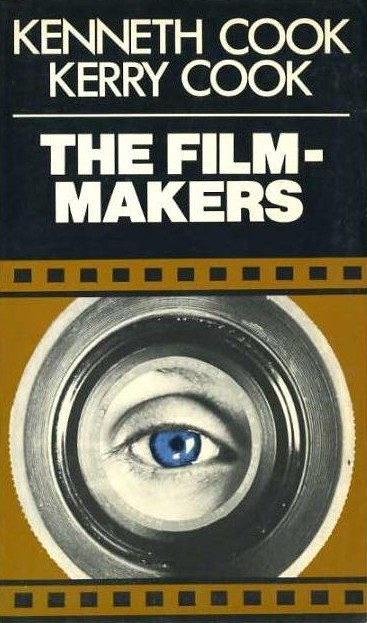 definitely knew the world he was writing about, having been a prolific screenwriter and documentary filmmaker—as for that matter did Kerry Cook, herself a movie and TV veteran.
definitely knew the world he was writing about, having been a prolific screenwriter and documentary filmmaker—as for that matter did Kerry Cook, herself a movie and TV veteran.
Unfortunately the authors’ first-hand knowledge is laid on a little too thickly, resulting in quite a few overlong and dull passages about the complex planning, networking and financial arrangements that figure into the making of an Australian feature film. That feature is an action thriller conceived by two obsessed filmmakers who gamble everything they have on its success.
Things don’t pick up until around 150 pages in, when one of the protagonists is involved in a plane crash in the desert. The resulting passages, in which the man attempts to survive in this parched, craggy landscape, are some of the most harrowing Cook has written. A subsequent episode involving a stunt that goes horrifically wrong and inadvertently turns the production into a snuff film is equally potent, but such things are the exception in this novel, which includes numerous subplots that are never satisfyingly resolved and a lengthy digression about the famous “dingo killed my baby” early-1980s murder case. The novel, in short, is bloated and unfocused in a very un-Kenneth Cook manner, and among his least successful efforts.
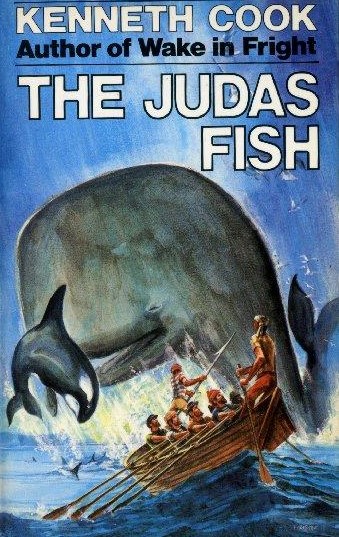 Thankfully, Cook bounced back in a major way with THE JUDAS FISH, which also appeared in 1983. The subject is the Australian whaling industry of the 1840s, which Cook brings to life with great vividness, and content that, as the author concedes in a brief nonfiction forward, often seems downright outrageous. Included is a two page bibliography of books used as research, in order to “justify the bizarre quality of many of the events which as a novelist I simply would not dare invent.”
Thankfully, Cook bounced back in a major way with THE JUDAS FISH, which also appeared in 1983. The subject is the Australian whaling industry of the 1840s, which Cook brings to life with great vividness, and content that, as the author concedes in a brief nonfiction forward, often seems downright outrageous. Included is a two page bibliography of books used as research, in order to “justify the bizarre quality of many of the events which as a novelist I simply would not dare invent.”
In THE JUDAS FISH Jonathan Church, a naïve young man, finds work on a whaling crew in a coastal village ruled over by David Hoyle, an amoral, power-mad heel (inspired by the 19th Century entrepreneur Benjamin Boyd). Hoyle makes his fortune through whaling, which as described here involves dozens of men packed into tiny boats who are led to their prey by the titular Judas and his fellow “fish”—killer whales, actually, who feel no loyalty to the much bigger right whales the men hunt.
Those hunts are wrenchingly bloody affairs, involving protracted bouts of stabbing at the massive whales until they die, with the local shark populations unwittingly aiding the men in their nasty business. Those men, I should add, don’t always fare much better than their prey, frequently emerging from the hunts crippled, crushed and even decapitated.
The narrative comes to involve romance, in the form of a Japanese immigrant woman with whom Jonathan falls in love, and a dive for an impossibly valuable pearl in a sunken ship. It’s an odd detour that diverts this gritty fact-based account into TREASURE ISLAND territory, although it nonetheless leads to a satisfying sea-set climax that neatly ties together the book’s characters and motifs.
Kenneth Cook finished out his writing career with the “Killer Koala” trilogy consisting of KILLER KOALA (1986), WOMBAT REVENGE and FRILL-NECKED FRENZY (both 1987), all containing uncharacteristically lighthearted stories about the fauna of the Australian outback. The “amusing obverse” of WAKE IN FRIGHT, the Killer Koala books were bestsellers in their native land, and appeared to herald a new direction for this iconoclastic talent. Sadly Kenneth Cook died of a heart attack in 1987.
There was, however, one more Cook novel in the pipeline: FEAR IS THE RIDER, which first saw print in 2016. As with most posthumously published fiction 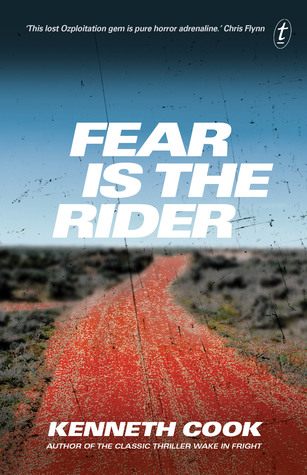 it’s far from perfect; there was clearly a reason this book, which reads like WAKE IN FRIGHT crossed with Steven Spielberg’s DUEL, never saw publication during its author’s lifetime. It is interesting, however, as an example of a horrific chase narrative stripped down to its bare essentials.
it’s far from perfect; there was clearly a reason this book, which reads like WAKE IN FRIGHT crossed with Steven Spielberg’s DUEL, never saw publication during its author’s lifetime. It is interesting, however, as an example of a horrific chase narrative stripped down to its bare essentials.
The setting is—once again—the Australian outback. John Shaw, an architect, is on a sojourn in a particularly untamed region, where the temperature is beyond sweltering and the surroundings are anything but welcoming. He meets up with Katie, a journalist looking for inspiration for future articles. It’s she who inadvertently attracts the attention of an axe-wielding maniac who may be supernaturally endowed, and who grows bound and determined to wipe John and Katie off the face of the Earth.
Cook succeeds in delivering a gripping and suspenseful account with some genuinely shivery set-pieces, but he evidently never got around to properly fleshing it out. We learn next to nothing about the protagonists or their pursuer outside the fact that they’re good and he’s bad, with all the dialogue being purely expository (sample exchange: “Have you got any matches?” “No.”). I’m all for minimalism in thrillers, but this one, I’m afraid, is plain undernourished.
That Kenneth Cook left behind a varied and impressive body of work is without question. In addition to the above, Cook’s literary output included a recounting of a family vacation (1963’s BLOOD RED ROSES), a movie novelization (1976’s ELIZA FRASER) and a musical drama (1975’s STOCKADE). What all these books have in common is that (WAKE IN FRIGHT and FEAR IS THE RIDER aside) they’re not particularly easy to find. I’m tempted to say that Kenneth Cook’s work will live on, but it seems that, tragically, that may not be the case.
Let’s hope I’m wrong.
